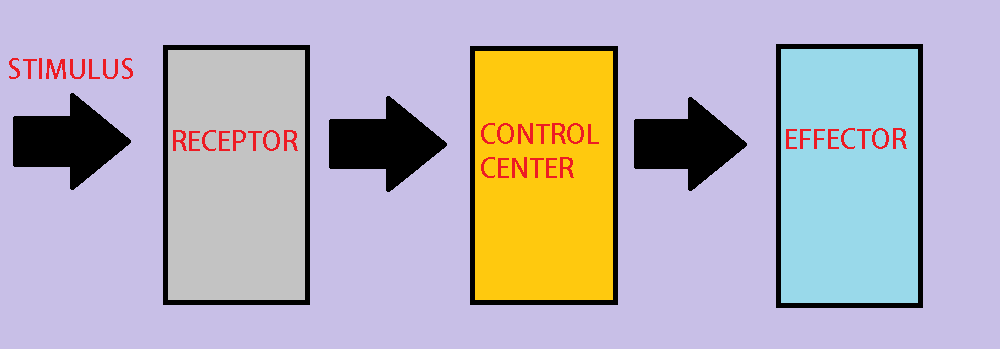Definition
A feedback mechanism is a physiological regulatory system that either returns the body to a normal internal state (homeostasis) or, less commonly, brings an internal system further away from homeostasis. Two mechanisms exist – negative and positive. These act via nerve pathways or chemicals such as hormones to cause a stimulatory or inhibitory effect. Feedback mechanisms are also found in ecosystems.
What is Feedback Mechanism?
In biology, a feedback mechanism is a physiological loop that brings the body either toward or away from the normal, steady state. The feedback mechanism, also referred to as a feedback loop, either amplifies a certain biological pathway or inhibits it. These pathways most commonly return the body to homeostasis. A homeostatic state refers to the stable state of the inner environment of organisms.

Both positive and negative feedback systems require three components to adjust specific physiological pathways:
- Receptor: (or sensor) receives information and sends this to the control center.
- Control center: (or evaluator) processes receptor information and stimulates the effector.
- Effector: carries out a stimulatory or inhibitory effect according to control center instructions.
Signals can be sent via nerve pathways (action potentials and neurotransmitters) or via chemical signals (most commonly, hormones).
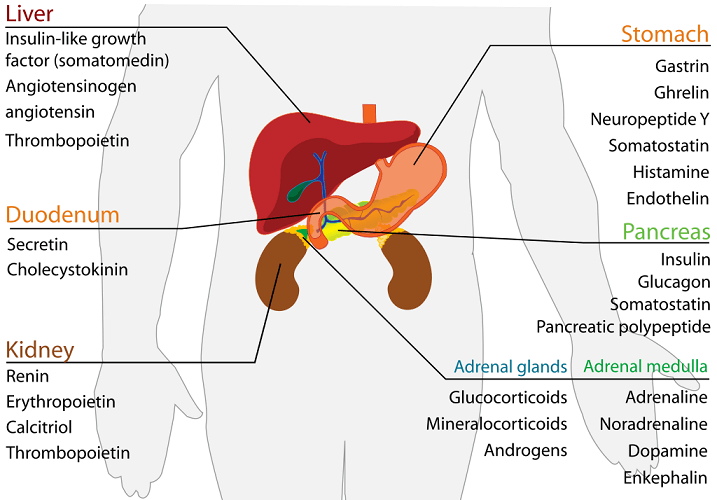
When we talk about physiology, we are usually discussing homeostasis within different systems. The body strives to produce a constant internal environment. It needs this stability to function at an optimal level.
If we are frightened by something, the heart rate increases and blood rushes to the vital organs and muscles to prepare us for escape. At a certain point, the body must return to homeostasis. It is unhealthy to remain in this excitable state for long periods of time. Most feedback mechanisms – negative ones – work to bring the body back to homeostasis.
Homeostasis can be affected by many things. Toxins in our environment, what we eat, our state of mind, how healthy we are, the makeup of our DNA, and the effects of medication and recreational drugs. Any of these can affect us at a cellular (receptor, control center, or effector) level and cause feedback mechanism abnormalities.

Alternatively, we also find feedback mechanisms in our environment. An ecosystem that supports a rabbit population might, for example, support the dietary requirements of three birds of prey. If that rabbit population is significantly reduced through disease, it can no longer support as many predators. One or two birds of prey must move on to find other food sources or starve. Once that rabbit population returns to normal, it can once again support multiple birds of prey. If the rabbit population continues to rise, other predators can move into that ecosystem. In this case, the healthiest predator to prey ratio is the equivalent of homeostasis.

Open and Closed-Loop Feedback Mechanisms
In an open-loop feedback mechanism, the regulatory steps are relatively simple. Input from receptors arrives at the control center and, after processing, that specific control center sends signals to associated effector cells.
In a closed-loop mechanism, an additional structure is at work. This continuously measures effector output and communicates this information directly to the receptor units. The extra structure – the comparator – will, therefore, affect what information arrives at the control center.
A good example of a closed-loop feedback mechanism is mammalian thermoregulation. In body temperature regulation, the comparator is located in the hypothalamus. As comparator, this tiny area has been told what normal body temperature should be.
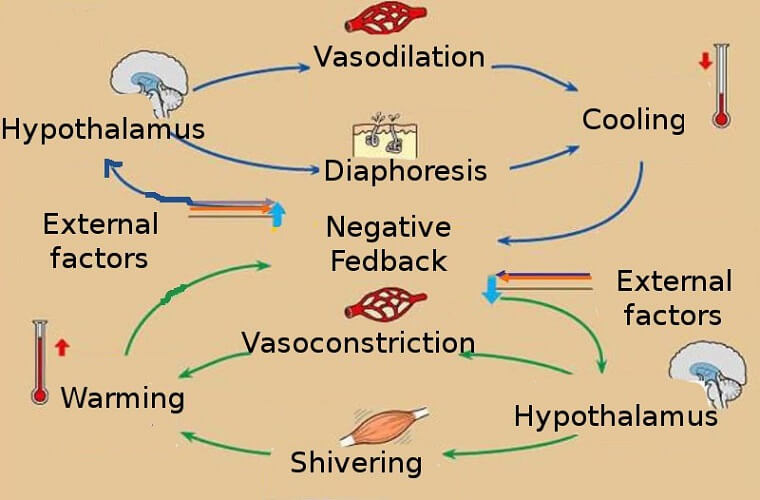
Thermoreceptors throughout the body are continuously sending information via nerve impulses to another area of the hypothalamus. This area is the thermoregulatory control center. Receptors detect changes in temperature variables. When abnormalities are found in these variables, receptors in that part of the body send warning signals to the hypothalamus. The control center will send nerve and/or chemical signals to the thermoregulatory effectors. These effectors are primarily found in the thyroid, blood vessel walls, and skeletal muscles.
When we are very cold, we become pale and shiver. Our metabolism speeds up (stimulated by thyroid hormone) as higher metabolism rates produce extra heat. The blood vessels close to the skin constrict to reduce heat loss to the external environment. Hairs on our arms stand up and add an extra layer of insulation. Muscle contractions generate additional heat. These are all the results of a negative feedback mechanism; the body is trying to return to a target value of 98.6°F (37°C).

When we are too hot, we become flushed and lethargic, and we sweat. Peripheral blood vessels dilate to increase their surface area and so allow body heat to be lost to the external environment. Lower levels of thyroid hormone are produced that slow the metabolic rate and reduce heat production inside the body. Sweat cools the body. This is also a negative feedback mechanism that attemps to bring the body temperature back to a normal level.

We do not want a positive feedback system for temperature control. Intentionally bringing the core body temperature out of homeostatic range can be fatal. The only example of a positive feedback mechanism in terms of thermoregulation occurs during extremely high fevers or when we are exposed for long periods to outdoor temperatures of 109°F and above. Such high temperatures raise the metabolic rate rather than decrease it; this further increases internal heat production. At this point, body heat will continue to rise until a fatal temperature is reached – around 113°F.
Without the comparator, the above thermoregulatory mechanism would be open-loop. However, the comparator makes thermoregulation a closed-loop system. Instead of relying solely on thermoreceptors, a different part of the hypothalamus constantly compares receptor and effector data with its programmed normal body temperature values. This means body temperature is always being monitored – after all, the most critical systems of the body depend on it.

Positive Feedback Mechanism
A positive feedback mechanism loop is a pathway that causes an effect that exceeds far beyond the state of homeostasis. It amplifies part of a physiological system that is already outside the homeostatic range. Very few positive loops exist in comparison to negative ones.
Positive feedback loops, just like the negative forms, require the combination of receptor, control center, and effector. They attempt to bring the body further away from the steady state of homeostasis. Examples of positive feedback mechanism can be found later on.
Negative Feedback Mechanism
A negative feedback mechanism cannot be seen as the opposite of a positive one. A positive feedback mechanism brings the body further outside of the range of homeostasis. This can be a stimulatory or inhibitory effect. What matters here is that the direction of the effect moves away from the homeostatic range.
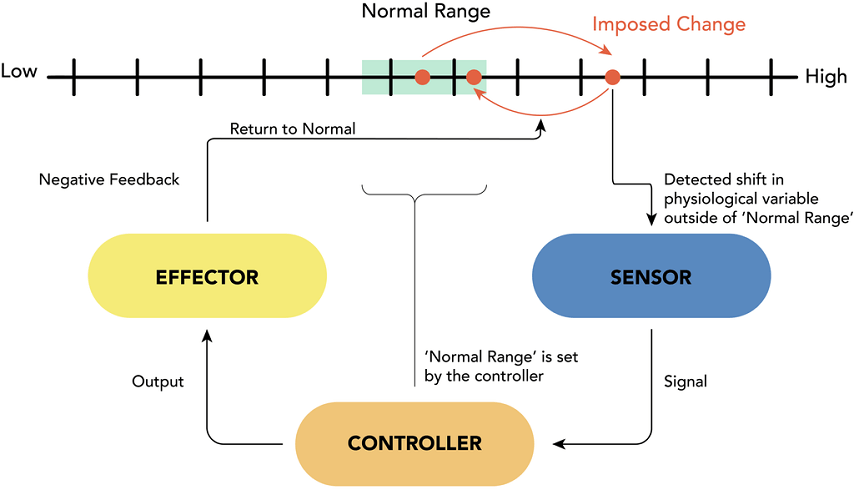
The negative feedback mechanism, on the other hand, brings body back toward homeostatic range. It is, therefore, more common than a positive feedback loop. Again, both stimulatory and inhibitory effects can be implemented to bring the body back to a normal state. For example, when we are too hot, less thyroid hormone is produced. Thyroid hormone production is inhibited to bring the body temperature back to normal range as part of a negative feedback mechanism. When we are too cold, thyroid hormone production is stimulated to increase body temperature –and this is also a negative feedback mechanism.
Feedback Mechanism Examples
There are thousands of feedback mechanism examples to choose from in the world of biology. We have already looked at thermoregulation and a simple ecosystem. Most are negative feedback mechanism examples as this is the most common type.
Think of any part of the body and you will be able to find a feedback loop in play. Blood sugar regulation in a healthy individual is controlled by two hormones:
- Insulin: decreases blood glucose concentration
- Glucagon: increases blood glucose concentration
After we eat, higher blood glucose levels are detected by beta cells (receptors) in the pancreas. The pancreas (control center) produces insulin. This hormone messenger tells the effector (the liver) to store excess blood glucose in the form of glycogen – an example of a negative feedback loop that returns high blood glucose to normal levels.
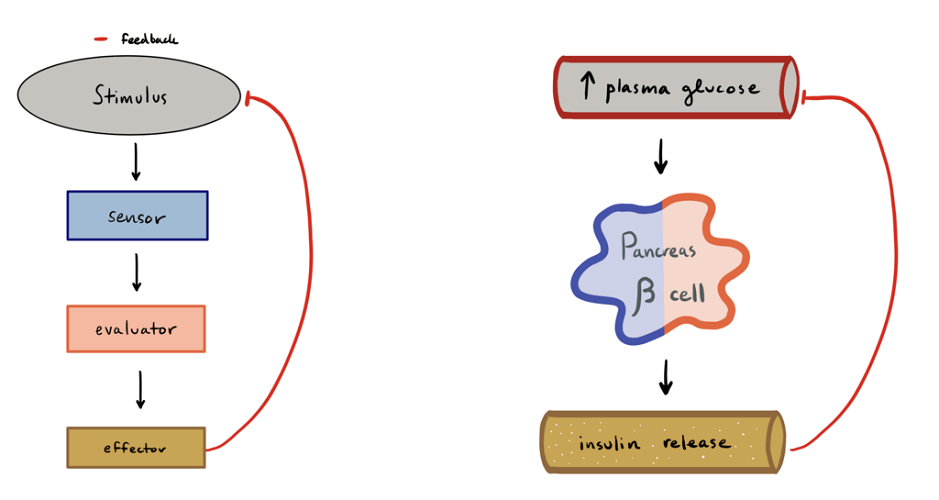
If we have not eaten for a long time, blood glucose becomes lower than normal range values. Alpha cells (receptors) in the pancreas send signals that are processed in other areas of the pancreas (control center). A decision is made to send a chemical signal in the form of glucagon to the liver (effector). The liver responds by breaking down its glucagon stores and manufacturing glucose. This brings a low blood glucose measurement back to normal levels. Another negative feedback loop.
Positive feedback mechanisms are often harmful as they intentionally bring the internal environment even further away from homeostasis. Cancer cells produce proteins that initiate positive feedback loops and contribute to the formation of tumors. They do this by extending the life of cells well beyond their normal (homeostatic) lifespan.
A good example of a positive feedback mechanism would be the cytokine storm. Coronavirus disease is known to produce this excessive inflammatory effect in humans. Excessive cytokine production as an inflammatory response to the virus can lead to multi-organ failure and death. A progressive increase in inflammatory effects that brings the body even further outside of the homeostatic norm makes this a positive feedback mechanism.

A more ‘positive’ positive feedback mechanism example in found in labor and childbirth; particularly the continuously-increasing production of oxytocin as the baby pushes on the cervix and travels through the birth canal. The receptors in this case are sensory cells in the womb and birth canal; the control center is the pituitary gland. The pituitary gland releases oxytocin as a chemical messenger (hormone) that tells the uterus (effector) to contract more strongly. When the female body is in homeostasis, the uterus does not contract. This is, therefore, a good positive feedback loop example.


